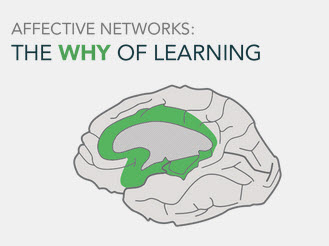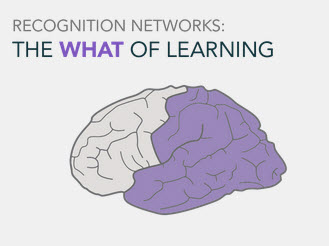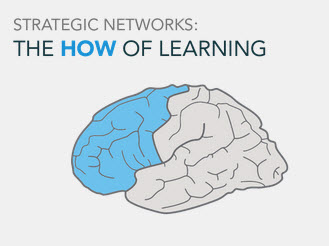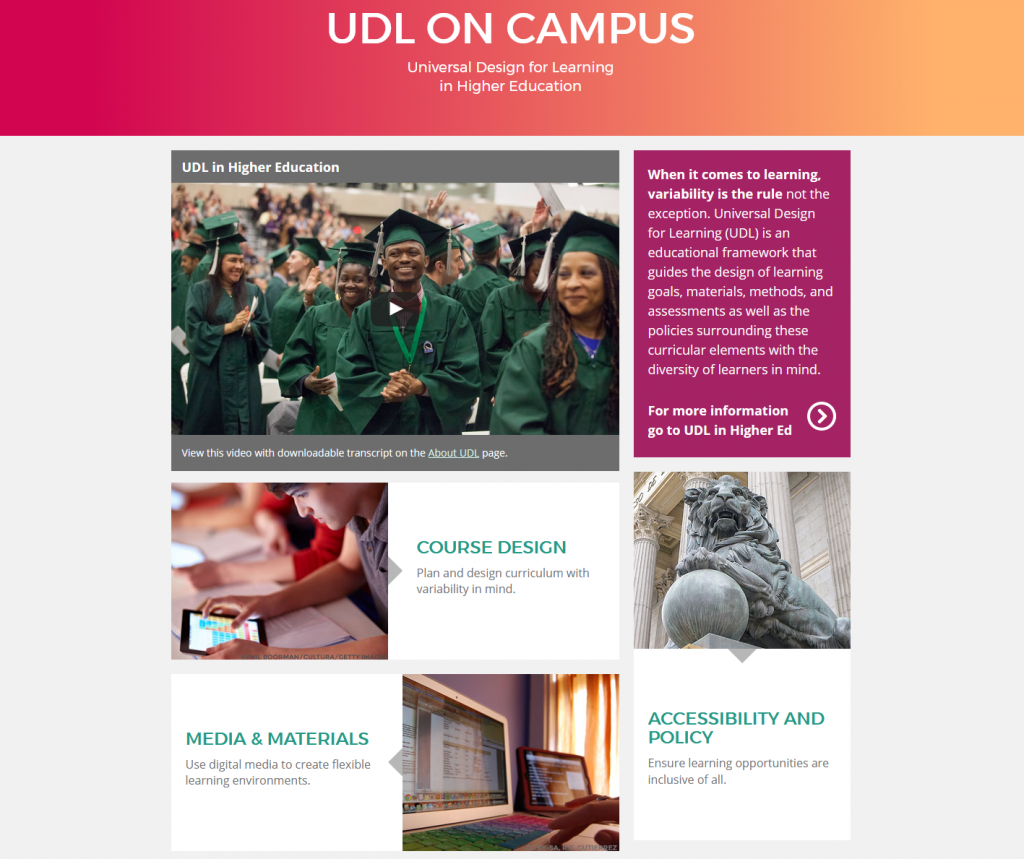Universal Design for Learning
Universal Design for Learning (UDL) is an educational framework and set of principles that maximizes learning opportunities for all learners. It is based on three main principles. Each principle has a set of detailed guidelines which provide an evidence-based approach to understanding how we can improve learning through tools and resources. Each principle is aimed at helping educators improve how we present information, engage students, and create inclusive assessments and evaluations.
UDL principles can be applied to the overall design of a course as well as to the specific instructional materials and strategies such as lectures, learning activities, learning resources, discussions, group work, handouts, on-line instruction, labs, field work, and demonstrations.
Universally designed curriculum provides students with multiple or flexible ways of viewing or listening to information (representation), expression, and engagement and makes a classroom more inclusive. Universally Designed curriculum reduces the need for special accommodation for students with disabilities.
Why is UDL important?
As educators we are often challenged to design and deliver curriculum for an increasingly diverse student population. Each student learns differently and can benefit from having a variety of learning formats to choose from, flexible assessments, and tools to help with organization of new information and skills. UDL provides us with a variety of strategies and resources to help meet diverse learning needs, improve accessibility to learning opportunities, and increase student success.
Three principles of UDL

Provide multiple means of engagement
Do you create a learning environment in which learners are challenged, excited and motivated about what they are learning?
How are you engaging your students?
Download the UDL interactive tip sheet for faculty

Provide multiple means of representation
Do you create a learning environment in which material and content are presented in a variety of ways?
How are you representing your content?
Download the UDL interactive tip sheet for faculty

Provide multiple means of action and expression
Do you create a learning environment in which students can express their comprehension in multiple ways?
How are you encouraging expression?
Download the UDL interactive tip sheet for faculty
UDL principle 1: Multiple means of engagement
Do you create a learning environment in which learners are challenged, excited and motivated about what they are learning?
| What you can do | Ideas | Examples/support |
|---|---|---|
| Challenge students with meaningful, “real world” assignments | Create evaluations that are performance based and allow students to demonstrate the learning outcomes | UDL assessment and evaluation ideas |
| Create a class climate in which student diversity is respected | At the beginning of the semester, have students generate a list of ground rules for classroom conduct Be sure to post the agreed upon list and refer to it when necessary | Establishing ground rules |
| Give prompt and instructive feedback on assignments | Post grades on Blackboard on a regular basis Allow students to hand in a rough draft of a paper or assignment | Blackboard support |
| Supplement lecture and reading assignments with visual aids (e.g. photographs, videos, diagrams, interactive simulations) | Provide students with a list of questions to answer when reading Have students watch a video on the topic as well as reading the chapter | Sample advance organizers |
| Make yourself available to students during office hours in flexible formats | Have different types of “office hours” – example: F-2-F office times, telephone, and virtual office hours Interact on WebEx where you can view the student’s screen and they can view yours | WebEx |
| Provide tasks that allow for active participation, exploration and experimentation | Use a variety of active learning strategies to engage a variety of learners in your online classroom | List of technology to aid in active learning online |
UDL principle 2: Multiple means of representation
Do you create a learning environment in which material and content are presented in a variety of ways?
| What you can do | Ideas | Examples/support |
|---|---|---|
| Ensure your course syllabus clearly describes the content and your expectations of the students | Use your outline as an advance organizer or study guide to go over expectations for the following week (i.e. readings, focus questions, videos to watch etc.) | Advance organizers A Graphic Syllabus Can Bring Clarity to Course Structure |
| Present information in multiple formats (e.g. lecture, text, graphics, audio, video, hands-on exercises) | Create a screencast explaining a major assignment | Screencast-o-matic – Free online screencast tool |
| Begin each week with an outline of what will be covered | Start every week with an introduction so students know what to expect during class | These can be written or videos |
| Summarize key points throughout the course content and tie these points to the larger course objectives | Use unmarked self-checks to ensure students are understanding | Self checks in online learning |
| Provide alternative formats wherever you can. | If you create a screencast of a PowerPoint, also provide the PowerPoint as an alternative/additional resource | Caption YouTube Creating accessible documents and resources |
UDL principle 3: Multiple means of action and expression
Do you create a learning environment in which material and content are presented in a variety of ways?
| What you can do | Ideas | Examples/support |
|---|---|---|
| Use a variety of evaluation methodologies to allow students to express what they know in multiple ways | Example: Introductory Biology may include quizzes, case studies, model building, and an video presentation rather than just traditional tests and a final exam | A role for choice in student assignments |
| Give students choice in evaluation methodologies to demonstrate their learning Give students options to demonstrate mastery of the course learning outcomes | Give students the opportunity to choose which type of assignment they would like to complete Example: Students may choose one of the following evaluation methods; a mind map with written explanation, research report, or creating a video | Multiple means of expression assignment samples |
| Incorporate technologies that facilitate class communication and participation | Use discussion boards or blogs to help students who need more time to reflect on a topic Use surveys to allow all students to participate without feeling centred out | Blackboard support – Collaboration tools |
Additional resources

Universal Course Design – Carleton University